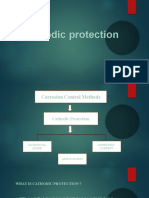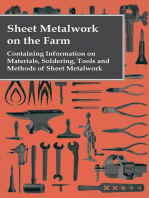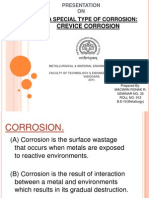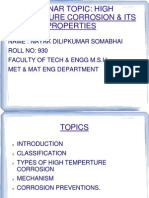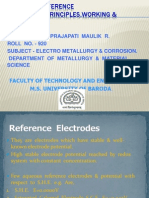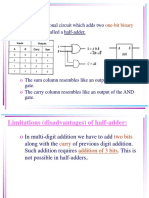A Seminar On Cathodic Protection Techniques
A Seminar On Cathodic Protection Techniques
Uploaded by
Devashish JoshiCopyright:
Available Formats
A Seminar On Cathodic Protection Techniques
A Seminar On Cathodic Protection Techniques
Uploaded by
Devashish JoshiOriginal Title
Copyright
Available Formats
Share this document
Did you find this document useful?
Is this content inappropriate?
Copyright:
Available Formats
A Seminar On Cathodic Protection Techniques
A Seminar On Cathodic Protection Techniques
Uploaded by
Devashish JoshiCopyright:
Available Formats
A SEMINAR ON CATHODIC PROTECTION TECHNIQUES
PREPARED BY: VIBHANSHU KOHLI ROLL NO. : 909
Department of Metallurgical and Materials Engineering Faculty of Technology and Engineering The Maharaja Sayajirao University
1. CORROSION: Destruction or deterioration of a material because of reaction with its environment. Reaction can be chemical or electrochemical in nature. It involves loss of electrons i.e. oxidation and gain of electrons i.e. reduction. 2. WHY CORROSION PREVENTION IS ESSENTIAL? It reduces metal thickness leading to loss of mechanical strength and structural failure or breakdown. It can cause hazards or injuries to people arising from structural failure or breakdown. It reduces value of goods due to deterioration of appearance. It contaminates fluids in vessels and pipes. Perforation of vessels and pipes allowing escape of their contents and possible harm to the surroundings. Hence, losses due to corrosion are very high. So, corrosion and its prevention is a problem of great importance.
3. DIFFERENT TECHNIQUES OF CORROSION CONTROL: 1. Proper design 2. Use of high purity metals
3. Use of alloy additions 4. Use of special heat treatments 5. Use of inhibitors 6. Cathodic protection 7. Use of protective surface coatings 8. Environment control
4. CATHODIC PROTECTION TECHNIQUES: It is a very old and effective method to prevent corrosion. It is capable of completely preventing corrosion. 4.1 PRINCIPLE: It is accomplished by placing a metal that is higher in electro potential series with the metal which is to be protected. Hence, the metal which acts as an anode protects the metal which acts as cathode and it gets corroded. Hence, it is called sacrificial anode. 4.2 HISTORY: The first reported practical use of Cathodic protection is generally credited to Sir Humphrey Davy in the 1820s.He investigated the corrosion of copper sheeting used for cladding the hulls of naval vessels and found that he could preserve copper in seawater by the attachment of small quantities of iron, zinc or tin. The copper became cathodically protected.
4.3 TECHNIQUES OF APPLYING CATHODIC PROTECTION:
Cathodic protection mat be achieved in the following ways: 1. By the use of a sacrificial anode. 2. By the use of impressed current from an external source.
4.3.1. USE OF A SACRIFICIAL ANODE: Sacrificial anodic protection occurs when a metal is coupled to a more reactive (anode) metal. This connection is referred to as galvanic coupling. A metal which is more anodic is connected to a metal which is to be protected. The metal to be protected is less anodic i.e. acts as cathode. The anode in this case is called sacrificial anode since it is consumed during the protection of the structure.
ANODIC MATERIALS: Commercial sacrificial anodes include zinc, magnesium and aluminum. They should have sufficient potential difference so that they can supply electrons when connected. Zinc is used for cathodic protection in fresh water and marine water. It can also be used in low resistivity soils. It is used to protect mechanical components of the ship, coastal power plants, heat exchangers, etc. Magnesium anodes are most widely used for underground soil applications. They are used to protect underground pipelines. Aluminum anodes are less active than Zn and Mg anodes. They are used for protection of offshore structures, interiors of tanks. GALVANIC ZINC APPLICATION: a) Zinc metalizing (plating): Feeding zinc into a heated gun, where it is melted and sprayed on a structure or part using combustion gases or auxiliary compressed air. b) Zinc-rich Paints: Zinc-rich paints contain various amounts of metallic zinc dust and are applied by brush or spray. c) Hot-dip Galvanizing: Complete immersion of steel into a bath of molten zinc.
4.3.2. USE OF IMPRESSED CURRENT FROM AN EXTERNAL SOURCE: External source of direct current power is connected (or impressed) between the structure to be protected and the metal which acts anode. The anode used is surrounded by backfill consisting of coke breeze, gypsum or bentonite. The backfill helps to improve electric contact between the electrode and the surrounding medium (soil). Commercially used impressed current anodes are platinum, graphite, lead alloy, high silicon cast iron, etc.
PRINCIPLE: The metal connected directly to the positive terminal of the power supply behaves as an anode while the metal to be protected is connected to the negative terminal of the power supply. The anode gets corroded and the cathode is protected. The metal acting as anode is replaced once it gets corroded completely.
FIG:
CATHODIC
PROTECTION
OF
AN
UNDERGROUND
TANK/PIPE USING IMPRESSED CURRENTS
4.4 COMPARISON BETWEEN SACRIFICIAL ANODE AND IMPRESSED CURRENT CATHODIC SYSTEMS: SACRIFICIAL ANODE SYSTEM IMPRESSED CURRENT SYSTEM
SR. NO.
1. 2.
Simple Low maintenance Works best in conductive
Complex High maintenance It can work in low
3.
or
low
resistive
electrolytes 4. 5. Lower installation costs
conductive electrolytes High installation costs
Fixed driving voltage and Adjustable driving voltage current No external power is and current External power is required
6.
required
7.
It does not cause stray It can cause stray current current corrosion corrosion.
4.5 ADVANTAGES OF CATHODIC PROTECTION: The main advantage of cathodic protection over other forms of anticorrosion treatment is that it is applied simply by maintaining a dc circuit and its effectiveness may be monitored continuously. Economically feasible to replace anode system when required. It is applied to existing structures to prolong their life. Its main use is to protect steel structures buried in soil or immersed in water. Structures that are commonly protected by cathodic protection are the exterior surfaces of: Pipelines, Ships hulls, Storage tank bases, harbour structures, Steel sheet, etc Cathodic protection is also used to protect the internal surfaces of: Large diameter pipelines, Ships tanks, Storage tanks , Water-circulating systems 4.6 LIMITATIONS OF CATHODIC PROTECTION: Significant operation and maintenance requirements. Relatively large chance of premature failure or breakdown. Possibility of stray current causing interference damage to other metallic structures. It cannot be used to completely prevent atmospheric corrosion on metals. There is a possibility of stray current corrosion.
REFERENCES: 1. Fontana, M., and N. Greene, Corrosion Engineering, McGraw-Hill Book Company (1967). 2. Garverick, L., Corrosion in the Petrochemical Industry, ASM International (1994). 3. Davies, K., and R. Kean, Cathodic Protection, DTI publication (1981). 4. Scannell, W., and A. Sohanghpurwala, Cathodic Protection as a corrosion control alternative, CONCORR Inc. (1993). 5. Langill, T, Corrosion Protection: Basic corrosion theory and protection methods, American Galvanizers Association (2006).
You might also like
- Power Transmission (Interview Questions)Document11 pagesPower Transmission (Interview Questions)Ntando Mpiyakhe100% (4)
- Chapter 5 - CORROSION AND NON-FERROUS METALDocument60 pagesChapter 5 - CORROSION AND NON-FERROUS METALتاج نيسها33% (3)
- Cathodic PresentDocument51 pagesCathodic Presentravi chandra mavuri100% (1)
- VibhanshuDocument21 pagesVibhanshuDevashish JoshiNo ratings yet
- Selection of MaterialDocument16 pagesSelection of MaterialRiyaNo ratings yet
- Cathodic Protection: The BasicsDocument8 pagesCathodic Protection: The BasicsbookbumNo ratings yet
- Anodic Protection: Liquid Environment: Name: Muhammad Emir Rafiansyah Akbar NPM: 2006489193Document30 pagesAnodic Protection: Liquid Environment: Name: Muhammad Emir Rafiansyah Akbar NPM: 2006489193emir akbarNo ratings yet
- Cathodic Protection of Ships in Seawater 2Document14 pagesCathodic Protection of Ships in Seawater 2songsoinkorea313No ratings yet
- Cathodic Protection For Soil SteelDocument8 pagesCathodic Protection For Soil Steeldhawk94No ratings yet
- Cathodic ProtectionDocument15 pagesCathodic ProtectionmiraNo ratings yet
- Final Assessment (Bryar Khalil Abdullqadr)Document27 pagesFinal Assessment (Bryar Khalil Abdullqadr)Bryar XalilNo ratings yet
- Abhishek Mishra Arunn Kumar Manish Kumar: Corrosion Control MethodsDocument28 pagesAbhishek Mishra Arunn Kumar Manish Kumar: Corrosion Control MethodsVaibhav GuptaNo ratings yet
- Lecture Cathodic ProtectionDocument23 pagesLecture Cathodic ProtectionNoman RazaNo ratings yet
- Corrosion in The Oil Industry 1683626672Document51 pagesCorrosion in The Oil Industry 1683626672Rozil AnwarNo ratings yet
- 21SPTE313 - Lecture 10Document40 pages21SPTE313 - Lecture 10Mohamed SolimanNo ratings yet
- Corrosion and Its PreventionDocument28 pagesCorrosion and Its PreventionMehul Neha Bisht100% (2)
- Seminar ReportDocument8 pagesSeminar ReportLaxman HosamaniNo ratings yet
- Chapter 16Document5 pagesChapter 16dervis berk congerNo ratings yet
- HeliCoil Technical Information Corrosion Screw ThreadsDocument6 pagesHeliCoil Technical Information Corrosion Screw ThreadsAce Industrial SuppliesNo ratings yet
- Cathode ProtectionDocument8 pagesCathode ProtectionVishal SNo ratings yet
- (A) - Describe The Method of Cathodic Protection, and The Advantages and Disadvantages of The MethodDocument3 pages(A) - Describe The Method of Cathodic Protection, and The Advantages and Disadvantages of The MethodDon WillzNo ratings yet
- Sacrificial Anode Cathodic ProtectionDocument8 pagesSacrificial Anode Cathodic Protectionnero daunaxilNo ratings yet
- Need of Surface TreatmentDocument6 pagesNeed of Surface TreatmentRahul MoottolikandyNo ratings yet
- Corrosion & Non-Ferrous MetalDocument21 pagesCorrosion & Non-Ferrous Metalsiraphat.bmNo ratings yet
- A Review Paper On Impressed Current Cathodic Protection To Reinforcement-CHIRAGDocument6 pagesA Review Paper On Impressed Current Cathodic Protection To Reinforcement-CHIRAGAhmad Choiry Fajar Part IINo ratings yet
- Anti Corrosion JournalDocument4 pagesAnti Corrosion JournalJuandi CanNo ratings yet
- Marine Corrosion ProtectionDocument13 pagesMarine Corrosion ProtectionHitesh VishnuNo ratings yet
- CORROSIONDocument19 pagesCORROSIONTH Rongon100% (1)
- Cathodic ProtectionDocument22 pagesCathodic ProtectiondevanbongiriNo ratings yet
- تقرير تأكل (Anodic Protection)Document10 pagesتقرير تأكل (Anodic Protection)ياسر نوفل ورد100% (1)
- 1 SMDocument6 pages1 SMLimuel EspirituNo ratings yet
- Cathodic Protection PDFDocument24 pagesCathodic Protection PDFJorge Luis Clavijo Iturri67% (3)
- Corrosion Control Methods: Dr. K. Rajendra Kumar Department of Chemistry VIT University Chennai Campus ChennaiDocument47 pagesCorrosion Control Methods: Dr. K. Rajendra Kumar Department of Chemistry VIT University Chennai Campus ChennaiRahul sandireddyNo ratings yet
- EMG 2201 Corrosion and Degradation of MaterialsDocument7 pagesEMG 2201 Corrosion and Degradation of Materialscuck5727No ratings yet
- WINSEM2018-19 - CHY1701 - ETH - SJT304 - VL2018195004125 - Reference Material I - EC - Module-4-Corrosion ProtectionDocument61 pagesWINSEM2018-19 - CHY1701 - ETH - SJT304 - VL2018195004125 - Reference Material I - EC - Module-4-Corrosion ProtectionkumarklNo ratings yet
- Module 4 - Mol - ElectronicsDocument71 pagesModule 4 - Mol - Electronicsbhagatkrishnakbfc17No ratings yet
- Presentation - Painting, Coating & Corrosion Protection - Beca - Cathodic ProtectionDocument56 pagesPresentation - Painting, Coating & Corrosion Protection - Beca - Cathodic Protectionzinha_al100% (1)
- Process Equipment DesignDocument3 pagesProcess Equipment DesignakshaylattimardiNo ratings yet
- 5 Designing To Prevent Corrosion: E. D. Verink, JRDocument13 pages5 Designing To Prevent Corrosion: E. D. Verink, JRMohd Nizamuddin Mohamad NoorNo ratings yet
- Cathodic CorrosionDocument16 pagesCathodic CorrosionDavid KanuNo ratings yet
- 01.4TB.047 X-R RatioDocument4 pages01.4TB.047 X-R RatioJohn Philip BuntalesNo ratings yet
- Forging - Manual of Practical Instruction in Hand Forging of Wrought Iron, Machine Steel and Tool Steel; Drop Forging; and Heat Treatment of Steel, Including Annealing, Hardening and TemperingFrom EverandForging - Manual of Practical Instruction in Hand Forging of Wrought Iron, Machine Steel and Tool Steel; Drop Forging; and Heat Treatment of Steel, Including Annealing, Hardening and TemperingRating: 5 out of 5 stars5/5 (1)
- Sheet Metalwork on the Farm - Containing Information on Materials, Soldering, Tools and Methods of Sheet MetalworkFrom EverandSheet Metalwork on the Farm - Containing Information on Materials, Soldering, Tools and Methods of Sheet MetalworkNo ratings yet
- Tool-Steel - A Concise Handbook on Tool-Steel in General - Its Treatment in the Operations of Forging, Annealing, Hardening, Tempering and the Appliances ThereforFrom EverandTool-Steel - A Concise Handbook on Tool-Steel in General - Its Treatment in the Operations of Forging, Annealing, Hardening, Tempering and the Appliances ThereforNo ratings yet
- Cathodic Protection: Industrial Solutions for Protecting Against CorrosionFrom EverandCathodic Protection: Industrial Solutions for Protecting Against CorrosionNo ratings yet
- Sexton's Pocket-Book for Boiler-Makers and Steam Users: Comprising a Variety of Useful Information for Employer and Workmen, Government Inspectors, Board of Trade Surveyors, Engineers in Charge of Works and Ships, Foreman of Manufactories, and the General Steam-Using PublicFrom EverandSexton's Pocket-Book for Boiler-Makers and Steam Users: Comprising a Variety of Useful Information for Employer and Workmen, Government Inspectors, Board of Trade Surveyors, Engineers in Charge of Works and Ships, Foreman of Manufactories, and the General Steam-Using PublicNo ratings yet
- Triangulation - Applied to Sheet Metal Pattern Cutting - A Comprehensive Treatise for Cutters, Draftsmen, Foremen and Students: Progressing from the Simplest Phases of the Subject to the Most Complex Problems Employed in the Development of Sheet Metal Patterns with Practical Solutions of Numerous Problems of Frequent Occurrence in Sheet Metal ShopsFrom EverandTriangulation - Applied to Sheet Metal Pattern Cutting - A Comprehensive Treatise for Cutters, Draftsmen, Foremen and Students: Progressing from the Simplest Phases of the Subject to the Most Complex Problems Employed in the Development of Sheet Metal Patterns with Practical Solutions of Numerous Problems of Frequent Occurrence in Sheet Metal ShopsRating: 5 out of 5 stars5/5 (1)
- Why Do Metals Rust? An Easy Read Chemistry Book for Kids | Children's Chemistry BooksFrom EverandWhy Do Metals Rust? An Easy Read Chemistry Book for Kids | Children's Chemistry BooksNo ratings yet
- Heat-Treatment of Steel: A Comprehensive Treatise on the Hardening, Tempering, Annealing and Casehardening of Various Kinds of Steel: Including High-speed, High-Carbon, Alloy and Low Carbon Steels, Together with Chapters on Heat-Treating Furnaces and on Hardness TestingFrom EverandHeat-Treatment of Steel: A Comprehensive Treatise on the Hardening, Tempering, Annealing and Casehardening of Various Kinds of Steel: Including High-speed, High-Carbon, Alloy and Low Carbon Steels, Together with Chapters on Heat-Treating Furnaces and on Hardness TestingRating: 1 out of 5 stars1/5 (1)
- Wrought Ironwork - A Manual of Instruction for Rural CraftsmenFrom EverandWrought Ironwork - A Manual of Instruction for Rural CraftsmenRating: 5 out of 5 stars5/5 (1)
- A Practical Workshop Companion for Tin, Sheet Iron, and Copper Plate Workers: Containing Rules for Describing Various Kinds of Patterns used by Tin, Sheet Iron, and Copper Plate Workers, Practical Geometry, Mensuration of Surfaces and Solids, Tables of the Weights of Metals, Lead Pipe, Tables of Areas and CircumferencesFrom EverandA Practical Workshop Companion for Tin, Sheet Iron, and Copper Plate Workers: Containing Rules for Describing Various Kinds of Patterns used by Tin, Sheet Iron, and Copper Plate Workers, Practical Geometry, Mensuration of Surfaces and Solids, Tables of the Weights of Metals, Lead Pipe, Tables of Areas and CircumferencesNo ratings yet
- Ironwork - Part III - A Complete Survey of the Artistic Working of Iron in Great Britain from the Earliest TimesFrom EverandIronwork - Part III - A Complete Survey of the Artistic Working of Iron in Great Britain from the Earliest TimesNo ratings yet
- Technical Manual - The Blacksmith and the Welder - June 16, 1941From EverandTechnical Manual - The Blacksmith and the Welder - June 16, 1941No ratings yet
- Metallic Coatings For Corrosion PreventionDocument9 pagesMetallic Coatings For Corrosion PreventionDevashish JoshiNo ratings yet
- Vipul Mevasiya ContentDocument15 pagesVipul Mevasiya ContentDevashish JoshiNo ratings yet
- Seminar ON Significance of H - H O-O Lines in Pourbaix DiagarmDocument10 pagesSeminar ON Significance of H - H O-O Lines in Pourbaix DiagarmDevashish JoshiNo ratings yet
- Ronak Mehta ContentDocument12 pagesRonak Mehta ContentDevashish JoshiNo ratings yet
- Mitesh ContentDocument18 pagesMitesh ContentDevashish JoshiNo ratings yet
- Electric Discharg Machining: Parikh Krutik R. ROLL NO.931Document6 pagesElectric Discharg Machining: Parikh Krutik R. ROLL NO.931Devashish JoshiNo ratings yet
- Dinkar Kokje ContentDocument8 pagesDinkar Kokje ContentDevashish JoshiNo ratings yet
- Anil Vaghamshi ContentDocument6 pagesAnil Vaghamshi ContentDevashish JoshiNo ratings yet
- Types of Methods of Powder Production:: Physico Chemical Processes Are As UnderDocument11 pagesTypes of Methods of Powder Production:: Physico Chemical Processes Are As UnderDevashish JoshiNo ratings yet
- Detecting Susceptibility To Intergranular Corrosion: Seminar ONDocument12 pagesDetecting Susceptibility To Intergranular Corrosion: Seminar ONDevashish JoshiNo ratings yet
- Nidhi Shah ContentDocument6 pagesNidhi Shah ContentDevashish JoshiNo ratings yet
- Gaurav Chudasama ContentDocument11 pagesGaurav Chudasama ContentDevashish JoshiNo ratings yet
- Prevention From Inter-Granual CorrosionDocument7 pagesPrevention From Inter-Granual CorrosionDevashish JoshiNo ratings yet
- Krunal Vora ContentDocument14 pagesKrunal Vora ContentDevashish JoshiNo ratings yet
- A Seminar On Electrolytic Production of Metallic Powder: Prepared By: Darshit Fadadu ROLL NO: 938Document13 pagesA Seminar On Electrolytic Production of Metallic Powder: Prepared By: Darshit Fadadu ROLL NO: 938Devashish JoshiNo ratings yet
- Electrometallurgy and Corrosion Seminar On Fuel Cells: Name: Anirudh Gupta ROLL NO.: 902 YEAR: 2011Document10 pagesElectrometallurgy and Corrosion Seminar On Fuel Cells: Name: Anirudh Gupta ROLL NO.: 902 YEAR: 2011Devashish JoshiNo ratings yet
- Tushal KyadaDocument11 pagesTushal KyadaDevashish JoshiNo ratings yet
- VaishaliDocument15 pagesVaishaliDevashish JoshiNo ratings yet
- Fe-H2O System in Pourbaix Diagram: Seminar Topic OnDocument21 pagesFe-H2O System in Pourbaix Diagram: Seminar Topic OnDevashish JoshiNo ratings yet
- Seminar Topic On Galvanic Corrosion ParametersDocument6 pagesSeminar Topic On Galvanic Corrosion ParametersDevashish JoshiNo ratings yet
- SUMITDocument27 pagesSUMITDevashish JoshiNo ratings yet
- Ronak MacwanDocument26 pagesRonak MacwanDevashish JoshiNo ratings yet
- Seminar Topic: High Temperature Corrosion & Its PropertiesDocument19 pagesSeminar Topic: High Temperature Corrosion & Its PropertiesDevashish JoshiNo ratings yet
- TrushitDocument22 pagesTrushitDevashish JoshiNo ratings yet
- KrutikDocument17 pagesKrutikDevashish JoshiNo ratings yet
- Mitesh PatelDocument25 pagesMitesh PatelDevashish Joshi100% (1)
- PriyankaDocument10 pagesPriyankaDevashish JoshiNo ratings yet
- Ravi VermaDocument21 pagesRavi VermaDevashish JoshiNo ratings yet
- MaulikDocument16 pagesMaulikDevashish JoshiNo ratings yet
- OHAUS Explorer Service ManualDocument114 pagesOHAUS Explorer Service ManualsambadeeNo ratings yet
- Global System For MobilesDocument169 pagesGlobal System For MobilesVijju ChinnaNo ratings yet
- User Guide Manual: Check Out The OX SUSPENSION ADAPTERS PATENT Inside!Document12 pagesUser Guide Manual: Check Out The OX SUSPENSION ADAPTERS PATENT Inside!Jimmy Kuka100% (1)
- 9852 1585 01a ProComDocument30 pages9852 1585 01a ProComLuis Segovia CortesNo ratings yet
- Prolink System: A Cost-Effective and Versatile Loss Prevention Solution That Helps Generate SalesDocument2 pagesProlink System: A Cost-Effective and Versatile Loss Prevention Solution That Helps Generate SalesIvson De Alcântara CruzNo ratings yet
- Wire Antenna Modelling With NEC-2Document10 pagesWire Antenna Modelling With NEC-2Raden Adhi Ramdhani MegantaraNo ratings yet
- Simulation in OpnetDocument8 pagesSimulation in OpnetPrateekKumarNo ratings yet
- Notice 2 Seektech SR 20Document108 pagesNotice 2 Seektech SR 20Johakim974No ratings yet
- Half-Adder:: One-Bit Binary NumbersDocument6 pagesHalf-Adder:: One-Bit Binary NumbersKiran AbbasNo ratings yet
- H264 Decoder C6678 UserGuideDocument93 pagesH264 Decoder C6678 UserGuidemahesh438No ratings yet
- watchOS 2 App PDFDocument321 pageswatchOS 2 App PDFJoshua SvNo ratings yet
- Power System Analysis: Complex Power, Reactive Compensation, Three PhaseDocument36 pagesPower System Analysis: Complex Power, Reactive Compensation, Three PhaseengrarNo ratings yet
- I CB ICBEdit 1.4.0 New FeaturesDocument8 pagesI CB ICBEdit 1.4.0 New FeaturesLuis JesusNo ratings yet
- 1 Electronic SymbolsDocument33 pages1 Electronic SymbolsOnil Alex VeranoNo ratings yet
- NDT4 - L2 Final Review (EOC) 020219Document13 pagesNDT4 - L2 Final Review (EOC) 020219Ibnu Hamdun100% (1)
- Chapter9 Unsymmetrical FaultsDocument53 pagesChapter9 Unsymmetrical Faultssuresh270No ratings yet
- Solenoid Valve (Proportional Reducing) - Calibrate - Negative Flow ControlDocument37 pagesSolenoid Valve (Proportional Reducing) - Calibrate - Negative Flow ControlBrahian Mijael Garrado Gonzales100% (2)
- H3I GVM Week 27 - 30Document39 pagesH3I GVM Week 27 - 30Sepradebe SNo ratings yet
- DGL 34-619Document69 pagesDGL 34-619ksg9731100% (1)
- Chemistry Xii RevisionDocument6 pagesChemistry Xii Revisionhoney1002No ratings yet
- ESC 201A ExpDocument4 pagesESC 201A Expanshikamittal2626No ratings yet
- BSNL Revised Tarrif MP CircleDocument20 pagesBSNL Revised Tarrif MP CircleAnand SantNo ratings yet
- Mascon Lsis-Vina 6-10-2011 v1Document16 pagesMascon Lsis-Vina 6-10-2011 v1giau richkyNo ratings yet
- What Is RTWP?: Statistics CategoriesDocument6 pagesWhat Is RTWP?: Statistics CategoriesOpeyemi DadaNo ratings yet
- Induction Motor EE 307 NewDocument25 pagesInduction Motor EE 307 NewVaradhanNo ratings yet
- FM TransmitterDocument9 pagesFM TransmitterMuhammad MujtabaNo ratings yet
- VLSI Implementation of A High Speed Single Precision Floating Point Unit Using VerilogDocument3 pagesVLSI Implementation of A High Speed Single Precision Floating Point Unit Using VerilogNsrc Nano ScientifcNo ratings yet
- Precision Workstation 650Document260 pagesPrecision Workstation 650giamba9No ratings yet
- HFSS+Tutorial EEC133 PDFDocument29 pagesHFSS+Tutorial EEC133 PDFeva1235xNo ratings yet









